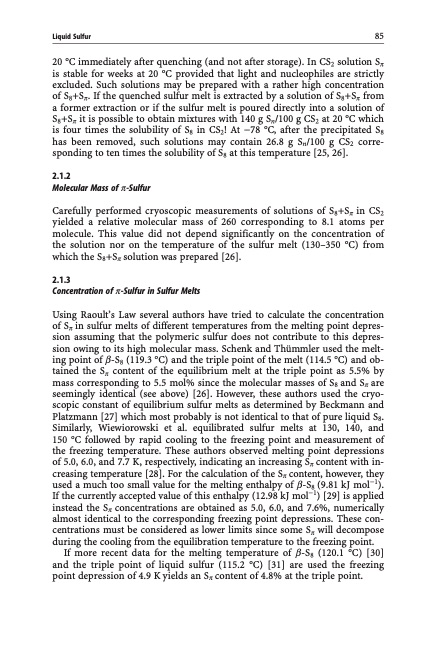
PDF Publication Title:
Text from PDF Page: 095
Liquid Sulfur 85 20 C immediately after quenching (and not after storage). In CS2 solution Sp is stable for weeks at 20 C provided that light and nucleophiles are strictly excluded. Such solutions may be prepared with a rather high concentration of S8+Sp. If the quenched sulfur melt is extracted by a solution of S8+Sp from a former extraction or if the sulfur melt is poured directly into a solution of S8+Sp it is possible to obtain mixtures with 140 g Sn/100 g CS2 at 20 C which is four times the solubility of S8 in CS2! At 78 C, after the precipitated S8 has been removed, such solutions may contain 26.8 g Sn/100 g CS2 corre- sponding to ten times the solubility of S8 at this temperature [25, 26]. 2.1.2 Molecular Mass of p-Sulfur Carefully performed cryoscopic measurements of solutions of S8+Sp in CS2 yielded a relative molecular mass of 260 corresponding to 8.1 atoms per molecule. This value did not depend significantly on the concentration of the solution nor on the temperature of the sulfur melt (130–350 C) from which the S8+Sp solution was prepared [26]. 2.1.3 Concentration of p-Sulfur in Sulfur Melts Using Raoults Law several authors have tried to calculate the concentration of Sp in sulfur melts of different temperatures from the melting point depres- sion assuming that the polymeric sulfur does not contribute to this depres- sion owing to its high molecular mass. Schenk and Thümmler used the melt- ing point of b-S8 (119.3 C) and the triple point of the melt (114.5 C) and ob- tained the Sp content of the equilibrium melt at the triple point as 5.5% by mass corresponding to 5.5 mol% since the molecular masses of S8 and Sp are seemingly identical (see above) [26]. However, these authors used the cryo- scopic constant of equilibrium sulfur melts as determined by Beckmann and Platzmann [27] which most probably is not identical to that of pure liquid S8. Similarly, Wiewiorowski et al. equilibrated sulfur melts at 130, 140, and 150 C followed by rapid cooling to the freezing point and measurement of the freezing temperature. These authors observed melting point depressions of 5.0, 6.0, and 7.7 K, respectively, indicating an increasing Sp content with in- creasing temperature [28]. For the calculation of the Sp content, however, they used a much too small value for the melting enthalpy of b-S8 (9.81 kJ mol1). If the currently accepted value of this enthalpy (12.98 kJ mol1) [29] is applied instead the Sp concentrations are obtained as 5.0, 6.0, and 7.6%, numerically almost identical to the corresponding freezing point depressions. These con- centrations must be considered as lower limits since some Sp will decompose during the cooling from the equilibration temperature to the freezing point. If more recent data for the melting temperature of b-S8 (120.1 C) [30] and the triple point of liquid sulfur (115.2 C) [31] are used the freezing point depression of 4.9 K yields an Sp content of 4.8% at the triple point.PDF Image | Topics in Current Chemistry

PDF Search Title:
Topics in Current ChemistryOriginal File Name Searched:
Elemental-Sulfur-und-Sulfur-Rich-Compounds-I.pdfDIY PDF Search: Google It | Yahoo | Bing
Sulfur Deposition on Carbon Nanofibers using Supercritical CO2 Sulfur Deposition on Carbon Nanofibers using Supercritical CO2. Gamma sulfur also known as mother of pearl sulfur and nacreous sulfur... More Info
CO2 Organic Rankine Cycle Experimenter Platform The supercritical CO2 phase change system is both a heat pump and organic rankine cycle which can be used for those purposes and as a supercritical extractor for advanced subcritical and supercritical extraction technology. Uses include producing nanoparticles, precious metal CO2 extraction, lithium battery recycling, and other applications... More Info
| CONTACT TEL: 608-238-6001 Email: greg@infinityturbine.com | RSS | AMP |